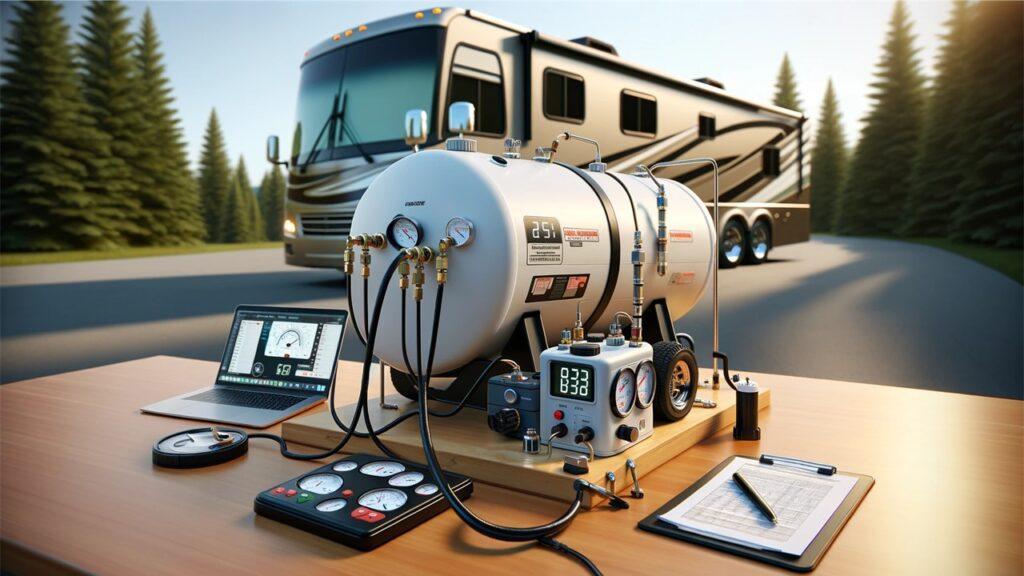
When you’re setting out on an adventure in your RV, the last thing you want is to worry about inaccurate readings from your tank sensors. Accurate readings from your fresh water, gray water, and black water sensors are fundamental to a smooth trip. In our guide, “How to Recalibrate RV Tank Sensors Accurately,” we’ll uncover the significance of these sensors and the typical troubles that many RV owners face. Moreover, we’ll walk you through a detailed recalibration process to ensure your sensors deliver the accuracy you depend on. Additionally, get ready to discover effective strategies to prevent common sensor issues, so you can focus on enjoying your motorhome adventures without unexpected hitches. Prepare to gear up your RV with knowledge and confidence, making every mile as enjoyable as your destinations.
Understanding RV Tank Sensors
Navigating the roads in your RV requires more than just a map; it demands fully functioning systems, especially your RV fresh water tank, gray water tank, black water tank sensors. These small yet crucial devices ensure you’re informed about the levels of fresh water, gray water, and black water in your tanks—vital for smooth and comfortable travel. Let’s delve into what these sensors are, why their accuracy is critical, and how they operate within the intricate systems of your RV.
What Are RV Tank Sensors?
RV tank sensors play a pivotal role in monitoring fluid levels within your RV’s water system. These sensors help ensure that you never run unexpectedly low on fresh water or overflow your waste tanks. Typically, there are three main types: sensors for fresh water, which tell you how much potable water you have left; gray water sensors, monitoring water from sinks and showers; and black water sensors, which alert you to the level of sewage containment.
Why Accurate Tank Sensors Matter for Your RV Experience
Accurate readings from these sensors are not just a convenience but a necessity. Inaccurate sensor data can lead to overfilled black water tanks, unpleasant odors, or worse, a backed-up system. Moreover, knowing the precise levels helps in planning maintenance stops and tank cleaning, which are essential for long-term RV care and functionality.
How Tank Sensors Work in RV Motorhomes and Campers
The technology behind RV tank sensors involves a series of probes or ultrasonic signals that measure liquid levels by either contact or proximity. Most RVs use a probe system, where sensors are placed at different heights in the tank. These sensors detect the electrical conductivity between the probes, changing with fluid contact. The common design ensures that whether you’re in a luxury motorhome or a compact camper van, you get reliable data.
Common Problems with RV Tank Sensors
Despite their importance, tank sensors often encounter issues like residue build-up or sensor misalignment, particularly in older or frequently used RVs. These problems can skew readings and misinform you about the actual tank levels, leading to maintenance challenges. Regular cleaning and recalibration are crucial to keep the sensors functioning properly.
Understanding the role and workings of your RV’s tank sensors is more than a technical necessity—it’s a cornerstone of a hassle-free RV experience. Keeping these sensors in check means you can hit the road with confidence, knowing that all aspects of your RV are as ready for adventure as you are. Equip yourself with the knowledge to maintain and troubleshoot your sensors, and you’ll enhance every aspect of your RV travels.
Preparing for Recalibration of Your RV Tank Sensors
Before recalibrating your RV tank sensors, it’s crucial to ensure that you have the right tools and understand when and how to undertake this task effectively. Recalibration is essential not only for accuracy but also for the longevity of your RV’s systems. Let’s break down what you’ll need, recognize the signs that it’s time for a recalibration, and go through the safety precautions and initial steps necessary to do this correctly.
Tools and Materials Needed for Recalibration
Starting with the proper tools and materials is key to successfully recalibrating your RV tank sensors. You’ll require specific items such as sensor cleaning brushes, a multimeter, and possibly a replacement sensor kit, should you find any sensors beyond repair. Furthermore, investing in high-quality cleaning solutions specifically designed for RV sensors will help remove the stubborn residues that can cause faulty readings. These products are formulated to be safe on the sensor components, ensuring they clean without causing damage.
When to Consider Recalibrating Your RV Tank Sensors
Knowing when to recalibrate your sensors can save you from unexpected issues during your travels. Signs that suggest a recalibration might be necessary include erratic sensor readings or sensors that consistently read full or empty. Additionally, it’s wise to schedule regular maintenance checks, ideally before and after prolonged storage periods or at least once a season, to ensure everything is functioning correctly.
Safety Precautions and Preparatory Steps
Safety should always be your first priority. Before starting the recalibration process, make sure to take all necessary safety precautions to protect both yourself and your RV’s intricate systems. This includes shutting off the power to the sensor system and ensuring that all tanks are drained completely to avoid any accidental spills or exposure to harmful substances. Wearing gloves and goggles during the cleaning and recalibration process can also provide an extra layer of protection.
As you prepare, disconnect all power sources and thoroughly clean the area around the sensors. This not only makes access easier but also prevents dirt from entering the tanks during the recalibration process. By following these steps, you’ll set yourself up for a successful recalibration, enhancing the reliability of your RV’s water system.
With the right preparation, recalibrating your RV fresh water, gray water, black water tank sensors can be a straightforward process that significantly boosts your RV’s operational efficiency. By ensuring you have the appropriate tools, recognizing when recalibration is needed, and following proper safety measures, you can maintain your RV’s tank sensors in top condition. This preparation not only contributes to smoother travels but also extends the life of your RV systems, letting you focus on the joys of RVing without the hassle of unexpected maintenance issues.
Step-by-Step Guide to Recalibrating RV Tank Sensors
Recalibrating your RV tank sensors might seem daunting, but with the right guidance, it can be a straightforward task that ensures your RV’s systems run smoothly during your adventures. This guide will walk you through the necessary steps to accurately recalibrate your sensors, helping you maintain an efficient and reliable RV.
Step 1: Gather Your Tools and Prepare the Area
Start by assembling all necessary tools, including a multimeter, sensor cleaning brushes, and high-quality sensor cleaner. Ensure your RV is level to provide accurate readings during the process. Disconnect the power to the sensor system and ensure all RV tanks are emptied to avoid any interference during recalibration.
Step 2: Clean the Sensor Probes
Access the sensor probes, which are typically located on the exterior of the RV’s tank. Use the sensor cleaning brushes and apply the cleaning solution you’ve gathered. Thoroughly scrub the probes to remove any residue or build-up that could affect readings. Rinse carefully with water if the manufacturer’s instructions permit it.
Step 3: Check and Adjust Sensor Connections
Using your multimeter, check the electrical connections and continuity of each sensor probe. Tighten any loose connections and replace any worn wires or components that could impact sensor performance. This step ensures that the electrical signal sent to the gauge is accurate and uninterrupted.
Step 4: Calibrate the Sensors
Follow your RV manufacturer’s guidelines to recalibrate each sensor. This typically involves adjusting the sensors to read correctly when the tanks are known to be empty and then again when they are full. Make adjustments until the sensor readings match the actual tank levels.
Step 5: Test the System
Once recalibration is complete, fill your RV tanks slightly to test the sensors under normal operating conditions. Check for consistent and accurate readings. If discrepancies continue, you may need to repeat the cleaning and calibration steps or consult with a professional RV mechanic.
Recalibrating your RV tank sensors is a crucial part of RV maintenance that should not be overlooked. By following these detailed steps, you can ensure that your RV provides reliable readings, allowing you to travel with confidence. Regular maintenance of your RV tank sensors not only prolongs their life but also enhances your overall RV experience, letting you focus more on enjoying your journey and less on potential mechanical issues.
Enhancing the Longevity of Your RV Tank Sensors
Ensuring the longevity of your RV tank sensors is not just about recalibration; it involves a proactive approach to maintenance and upgrades. By regularly maintaining and thoughtfully enhancing your sensors, you can significantly improve their performance and reliability, allowing you to travel with peace of mind. Let’s explore the best practices for maintenance and the advantages of upgrading your RV’s sensor system.
Regular Maintenance Tips for RV Tank Sensors
Consistent maintenance is key to extending the life of your RV tank sensors. Regular cleaning should be a staple in your RV care routine, using appropriate chemicals and cleaners specifically designed for sensor maintenance. This prevents the buildup of materials that can lead to inaccurate readings or sensor damage. Furthermore, routine inspections can help catch issues before they become serious, ensuring that your RV’s water system continues to function optimally. Integrating these practices after each long trip or before storing your RV can save you from future headaches.
Upgrades and Modifications to Improve Sensor Performance
As technology advances, so do the options for enhancing your RV tank sensors. Investing in technological upgrades like digital readout systems or ultrasonic sensors can provide more accurate and reliable measurements. Additionally, aftermarket products designed to protect sensors from harsh conditions are worth considering. While upgrading involves an upfront investment, the payoff comes in the form of reduced maintenance needs and fewer unexpected repairs. However, it’s important to weigh these benefits against the costs and ensure that any modifications are compatible with your existing RV systems.
Maintaining and upgrading your RV tank sensors is an essential part of ensuring your RV remains a reliable home-away-from-home. With regular maintenance, you can extend the life and accuracy of your sensors, while upgrades can offer enhanced performance that aligns with the latest in RV technology. By adopting these practices, you equip yourself with the tools necessary for a worry-free journey, letting you focus more on enjoying the scenic routes and less on the mechanics of your mobile abode. Remember, a small effort in upkeep today can prevent significant issues down the road, making every trip in your RV smoother and more enjoyable.
What to Do If Recalibration Fails
Even with the best efforts, there are times when recalibration of your RV tank sensors might not resolve the issues at hand. This can be frustrating, especially if you’re looking forward to a worry-free trip. Here, we delve into how to diagnose persistent issues effectively and explore the replacement options available if recalibration continues to fail.
How to Diagnose Persistent Issues with RV Tank Sensors
When RV tank sensors continue to show inaccurate readings despite your best recalibration efforts, it’s crucial to dig deeper to uncover the underlying problems. Start by conducting a thorough inspection of the sensor system to check for any signs of physical damage or wiring issues that could be affecting performance. Using advanced diagnostic tools, which might include specialized RV sensor diagnostics kits available in the market, can help identify electrical faults that aren’t obvious through visual inspection alone. If these steps feel out of your depth, consulting with a professional RV mechanic who has experience with RV electrical systems can provide the expertise needed to accurately diagnose and address complex sensor issues.
Replacement Options and Considerations for Faulty RV Tank Sensors
If diagnostics indicate that your sensors are beyond recalibration, considering replacement is the next step. Deciding when to replace rather than recalibrate involves assessing the cost-effectiveness of ongoing repairs versus installing new sensors. Newer sensor models might offer improved accuracy, durability, and less frequent need for recalibration. When choosing replacements, select sensors that are compatible with your RV model and type to ensure seamless integration and functionality. It’s also beneficial to consider sensors with enhanced features like wireless monitoring capabilities, which can provide added convenience and reliability.
Navigating the troubleshooting and replacement of RV tank sensors can be challenging, but understanding when and how to take these steps is crucial for maintaining the reliability of your RV’s essential systems. By recognizing when recalibration is no longer sufficient and opting for professional consultations or considering advanced replacements, you ensure that your RV remains a dependable companion on all your journeys. Remember, investing in quality sensors and regular maintenance goes a long way in enhancing your overall RV experience, letting you focus on the joy of traveling rather than technical troubles.
Wrapping It Up!
Throughout our exploration of recalibrating RV tank sensors, we’ve highlighted not just the steps, but the crucial importance of keeping these components in top shape. Accurate tank sensors are fundamental to ensuring a smooth and enjoyable RV experience, alerting you to potential issues before they become actual hassles. We’ve walked through the meticulous process of recalibration, from the initial preparation and cleaning to the actual calibration and subsequent testing.
Recalibration is more than a mere task; it’s an essential practice that safeguards the functionality and longevity of your RV’s essential systems. By following the step-by-step guide provided, you can maintain accuracy in your RV’s tank readings, ensuring peace of mind while you traverse the open road. Moreover, we delved into what to do if recalibration doesn’t resolve the issues, including how to diagnose persistent problems and when it might be time to consider replacing your sensors altogether.
Maintaining your RV tank sensors isn’t just a recommendation—it’s a necessity for anyone looking to avoid unexpected complications during their travels. Regular checks and maintenance ensure that your sensors remain reliable and efficient, enhancing your overall RV experience. So, take this knowledge forward, apply these practices regularly, and you’ll find that your adventures on the road are as smooth and enjoyable as the destinations themselves. Let’s keep our RVs in peak condition, ensuring every journey is as rewarding as the next.
Related FAQs
How Often Should I Recalibrate My RV Tank Sensors?
You should recalibrate your RV tank sensors at least once a year or after any significant maintenance.
Can I Recalibrate RV Tank Sensors Myself?
Yes, with the right tools and guidance, you can recalibrate RV tank sensors yourself.
What Causes RV Tank Sensors to Fail?
Common causes include residue buildup, sensor misalignment, and electrical faults.
Are There Signs That Indicate Sensor Failure Before Calibration?
Yes, erratic readings or consistent error messages are key indicators of sensor issues.
Do All RV Models Use the Same Type of Tank Sensors?
No, RV models vary, and the sensors may differ in type and complexity based on the RV’s design and age.
As outdoor enthusiasts ourselves, we understand the significance of reliable gear that can withstand the elements and support you throughout your journey. We try to provide as much real life information with our guides and how tos to the readers as possible. Our honest and transparent reviews of essential outdoor gadgets and products are rooted in testing and experience. We take great satisfaction in offering unbiased evaluations, ensuring that you can make informed decisions when investing in outdoor gear. As an affiliate website, we may earn a small commission from some of the products we feature. However, rest assured that our opinions are not influenced by this, and your trust is always our top priority.



